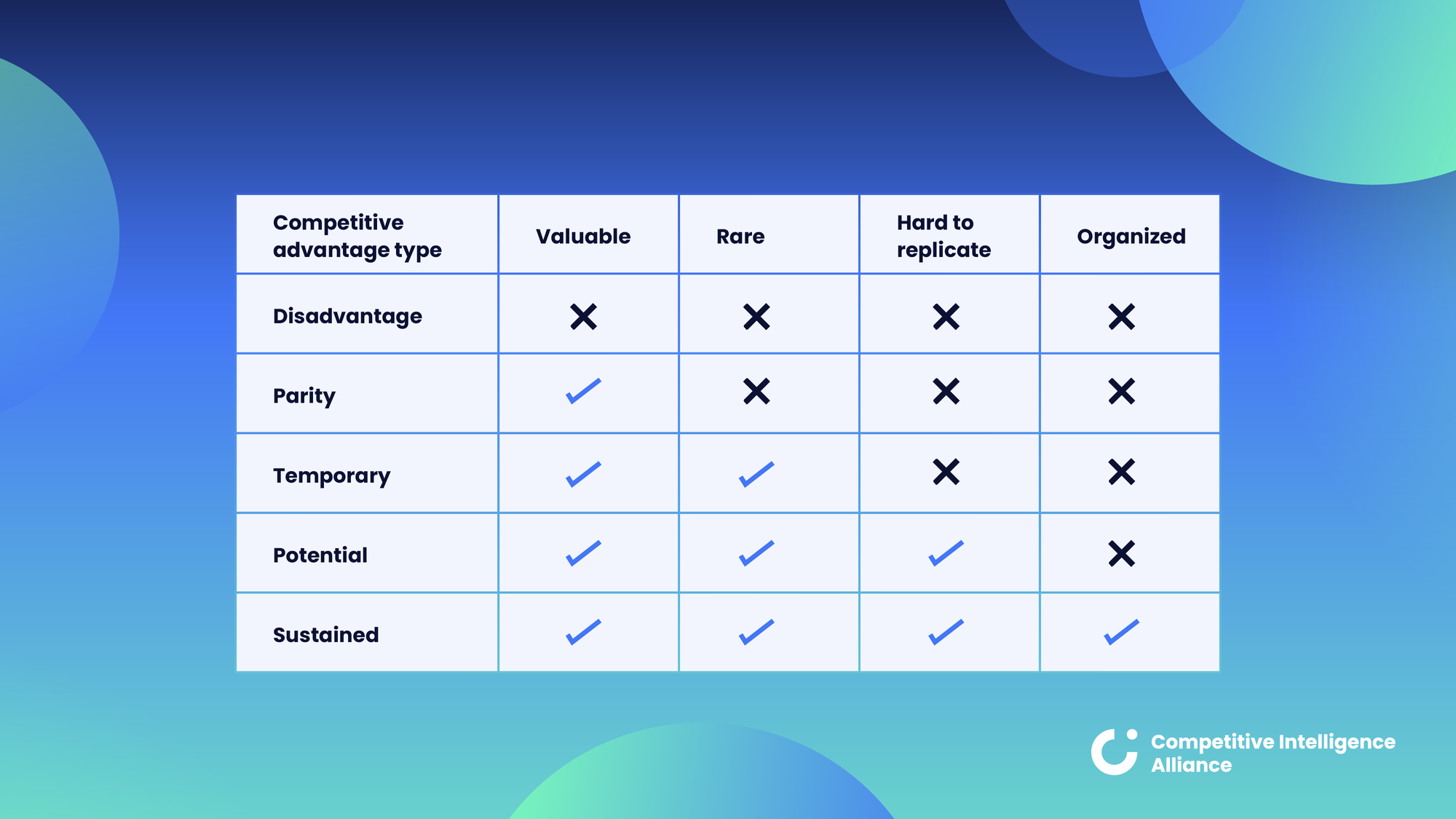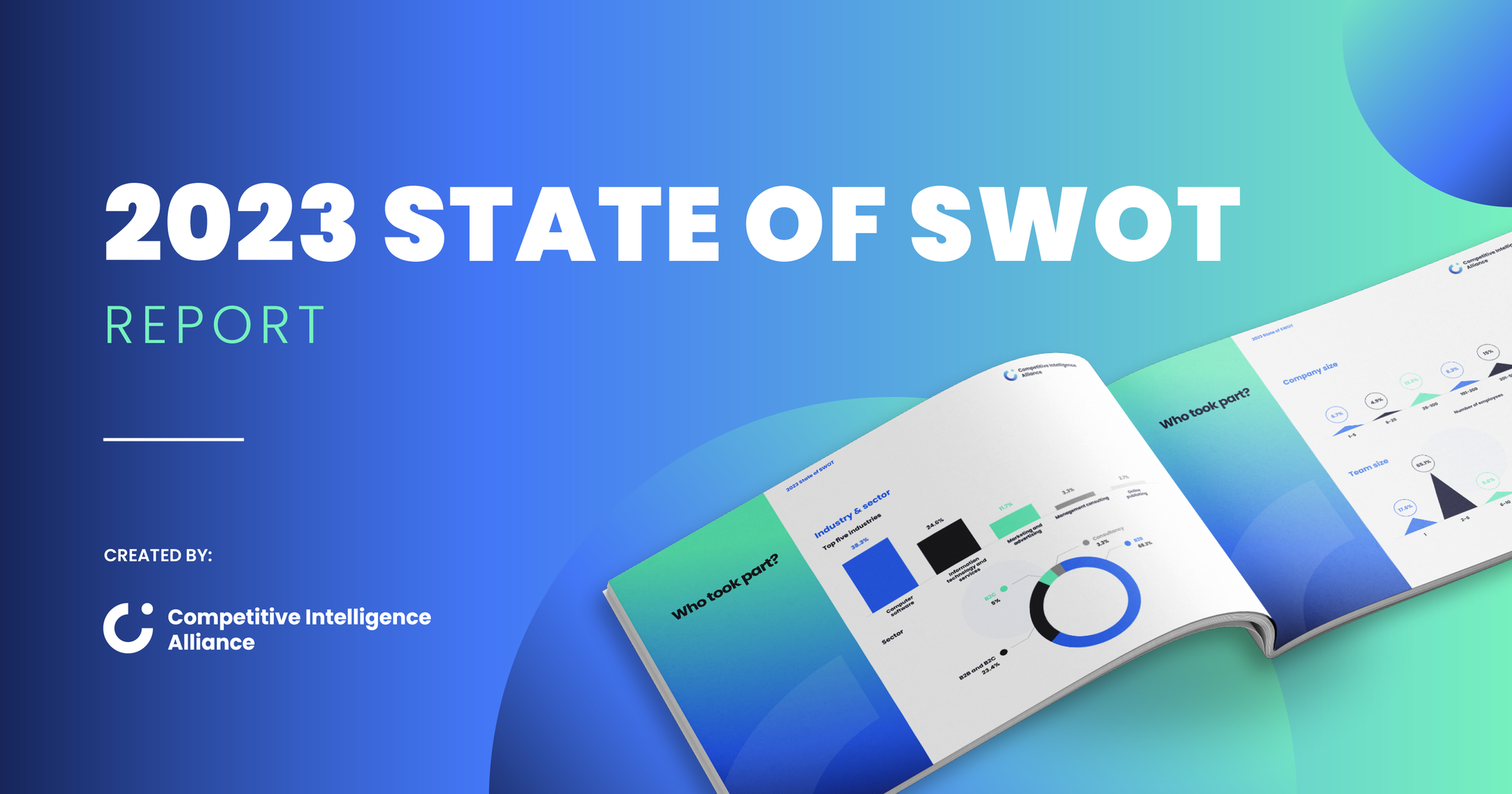SWOT is a strategic analysis framework. The four factors it has you examine are the strengths and weaknesses, opportunities and threats impacting your business. It has stood the test of time, but it has some weaknesses of its own no good strategy professional should ignore.
If you’re looking for a comprehensive strategic analysis of your business, of a competitor, or even of a project, you might want to account for these weaknesses by turning to an alternative to SWOT analysis.
Here are seven SWOT analysis alternatives you can use to do just that.
1) The VRIO framework
The VRIO framework is unlike the other SWOT alternatives on this list.
Those (and SWOT analysis itself) aim to help an analyst make sense of the various internal and/or external forces that can impact a business’ efforts to achieve its goals.
VRIO, meanwhile, helps a business identify its competitive advantages. Specifically, it asks an analyst to consider the business’ capabilities and resources, and grade them according to each of four factors:

For example, a capability or resource that is:
- Valuable
- Rare
- Inimitable
- Organized
…is said to constitute a sustained competitive advantage for that business.
By contrast, a capability or resource that’s valuable and rare, but not inimitable (difficult to imitate/replicate) or organized (being exploited in an organized way), is said to constitute a temporary competitive advantage for that business.
2) SOAR analysis
While a SWOT analysis examines both some internal and some external business factors, a SOAR analysis examines purely internal factors.
SOAR stands for:
- Strengths
- Opportunities
- Aspirations
- Results
SOAR has the strengths and opportunities factors in common with SWOT, but asks something SWOT analysis does not: what are your business’ aspirations? What are its goals?
In this way, SOAR covers what is perhaps one of SWOT analysis’ greatest weaknesses. SWOT doesn’t ask the practitioner to consider the business’ wider goals. A smart analyst might do this, but the SWOT framework doesn’t give any obvious guidance on how to incorporate them.
Is SOAR analysis better than SWOT analysis?
Most of the alternatives to SWOT analysis discussed here have their limitations when taken in isolation.
For a comprehensive analysis of your business or competitive landscape, it’s wise to combine multiple analytical tools.
SOAR analysis has the advantage of explicitly demanding that practitioners consider their org’s aspirations, as well as the concrete results they’d like to achieve.
This helps orient the analysis and keep things practical.
But a SOAR analysis examines only the positives. A SWOT analysis encourages analysts to keep on their guard against external threats and internal weaknesses as well, so arguably has fewer blind spots.

3) NOISE analysis
A NOISE analysis consists of the following factors:
- Needs
- Opportunities
- Improvements
- Strengths
- Exceptions
The NOISE analysis is similar to the SOAR analysis in that is has you consider your organization’s needs, and then has you identify areas for improvement.
Also like SOAR analysis, rather than focus on weaknesses and threats, the NOISE analysis aims to keep things positive. It uses solution focused language, and has you consider mere ‘exceptions’ to strengths, rather than overt weaknesses.
While a NOISE analysis doesn’t necessarily encourage practitioners to ignore negative aspects, other frameworks more explicitly call for practitioners to consider the possible negatives. This is a possible weakness of NOISE analysis that SWOT does not share.
4) PESTLE analysis
While the SOAR analysis purely examines factors internal to a business, it doesn’t go that much further than SWOT analysis itself.
One of the weaknesses our experts cited about SWOT analysis was that there are many external factors that could impact a business’ efforts to achieve its goals. The vanilla framework offers no insight as to what these factors could be.
PESTLE analysis, however, goes deep into possible external forces. The following are its six component factors:
- Political
- Economic
- Social
- Technological
- Legal
- Environmental
This fairly comprehensive list of factors that could impact a business and its future gives you a lot to think about.
That said, it’s easy to combine PESTLE and SWOT analysis, running through each of the six PESTLE elements as you’re considering SWOT threats and opportunities.
Which is better SWOT or PESTLE analysis?
The question isn’t really which analysis framework is better, so much as it’s which is more appropriate for your needs?
PESTLE calls attention to seven key macro factors that can impact your competitive landscape. Considering how these could impact your business, your products, and your competitors, and how the interplay between these should inform your strategy, is a solid approach to creating viable, forward-thinking business strategies.
SWOT analysis might lead you to uncover similar depth of insight, but it’ll help to work your way through each of the factors of PESTLE analysis while you’re considering opportunities and threats.
Combining both frameworks is a great idea, and a simple but robust way of looking at the spectrum of possible internal and external factors that shape your business’ strategy.

State of SWOT Report
Download your copy to learn...
- The five top challenges you face performing SWOT, and how to solve them.
- The best ways to measure success or failure post-SWOT.
- Whether SWOT is falling out of favor in modern businesses.
- The best alternative frameworks and how they compare with SWOT.
- The future of SWOT analysis.
5) PORTER’S five forces analysis
A Porter’s five forces analysis, like PESTLE, also considers factors purely external to the business.
‘Porter’ refers to the framework’s namesake, Harvard Business School professor Michael E. Porter, who wrote Competitive Advantage and Competitive Strategy, and first introduced the Five Forces in an article for Harvard Business Review in 1977.
The five forces are as follows:
- The threat of competition.
- The threat of new entrants.
- The threat of supplier bargaining power.
- The threat of customer bargaining power.
- The threat of substitutes.
As is the case with each of the elements of PESTLE analysis, each of Porter’s five forces has ramifications for entire industries.
The first force considers the threat of existing competition. The second, the threat of the possibility of new, emergent competition over time.
The third and fourth forces have to do with the threat of diminishing profit margins via the excess bargaining power of either suppliers or customers (or both). Suppliers can drive up purchase prices for raw materials, while customers can drive down sale prices.
Finally, the fifth force deals with the threat of alternative solutions to the market’s problem, making the solutions you’re selling redundant. (For example, DVDs to VHS, or Netflix to Blockbuster).

6) McKinsey 7-s framework
The McKinsey 7-s framework consists of seven factors. Unlike the previous two SWOT alternatives discussed, this one deals solely with internal factors.
It has you break down your organization into seven components. You’ll then consider how to align each element with the others to achieve a unified whole.
The seven components are:
- Strategy
- Structure
- Systems
- Skills
- Staff
- Style
- Shared values
If your business has strong systems in place, a proven strategy, and experienced, skilled staff, it has a lot going for it. But if values aren’t shared across the business, or if its structure isn’t conducive to effective collaboration, you have weaknesses that, once addressed, could pave the way for greater success.
7) TOWS analysis
Finally, some argue that reversing the order of the ‘SWOT’ acronym forces practitioners to look at the problem from a rarely-considered angle.
By first considering threats and opportunities (the external factors), these people argue that practitioners can access spurts of creative insight they might not otherwise have had access to had they stuck with the traditional order of considering the problem.
Rather than obsessing over your approach, and aiming to do an analysis the ‘right’ way, take inspiration from every possible source, and aim to be creative in your answers.
Conclusion
For a comprehensive analysis of your business (or of one of your competitors), it pays to pull inspiration from most, if not all, of the above frameworks.
For example, it’s difficult to determine your business’ strengths if you’re unaware of your leaders’ vision and goals for the business. These goals inform the business’ needs.
And if you’re to sidestep the inherent weaknesses of a framework like SWOT analysis, you’ll want to consider the exceptions called out in a NOISE analysis, and the additional external factors in PESTLE or Porter’s five forces analysis.
In short, a comprehensive analysis will incorporate the best elements of all of the above frameworks.
Download the State of SWOT Report
We had far more questions about SWOT analysis for our survey-takers.
🎯 Which SWOT applications offer the best ROI?
👍 How do you measure the success or failure of a SWOT analysis?
🔮 What does the future hold for SWOT analysis? And how do you overcome its inherent challenges?
Want to dig deeper into the reasons why modern attitudes towards SWOT are the way they are? Want to read the real comments and opinions of practitioners to learn how to improve your own application of strategic frameworks in your business?
Grab your no-cost copy of the report today and upgrade your competitive intelligence toolkit. 🧰






.png?v=09cf73b4b5)